The Alzheimer’s research field finally caught the man whose research fraud prevented them from finding the cure to this incurable disease. A bombshell story in Science is shaking the academic community. I provide you with my own unsolicited, incompetent and malicious take on the affair.
The image integrity sleuth in the centre of the Science story is Matthew Schrag, an assistant professor at Vanderbilt studying Alzheimer’s. He is the expert who exposed the Cassava Sciences fraud, a biotech start-up pushing a bullshit Alzheimer’s drug using fake western blots, as referenced in the short sellers’ report to the FDA. Elisabeth Bik soon took over the investigation, found more image forgery, plus falsified clinical trial data, and thus made herself the main target of hateful and misogynous attacks on social media. Cassava however are cartoonishly inept fraudsters, and the affair only shows how stupid and incompetent everyone around them was, not just investors and regulatory officials, but also the academic peer community including journal editors.
Cassava fraud and Alzheimer’s capitalism
“even Theranos didn’t submit fake data to FDA”
After Cassava, Schrag turned his sleuthing skills to something much bigger: the amyloid plaque hypothesis of Alzheimer’s, as Science now reported:
“The first author of that influential study, published in Nature in 2006, was an ascending neuroscientist: Sylvain Lesné of the University of Minnesota (UMN), Twin Cities. His work underpins a key element of the dominant yet controversial amyloid hypothesis of Alzheimer’s, which holds that Aβ clumps, known as plaques, in brain tissue are a primary cause of the devastating illness, which afflicts tens of millions globally. In what looked like a smoking gun for the theory and a lead to possible therapies, Lesné and his colleagues discovered an Aβ subtype and seemed to prove it caused dementia in rats. If Schrag’s doubts are correct, Lesné’s findings were an elaborate mirage.”
The article goes on to narrate how Schrag exposed Lesné’s fraud and reported it to NIH, with special focus on Lesne’s seminal paper in Nature from 2006, which Science says was decisive for all of last years’ Alzheimer’s research:
“One of its biggest mysteries is also its most distinctive feature: the plaques and other protein deposits that German pathologist Alois Alzheimer first saw in 1906 in the brain of a deceased dementia patient. In 1984, Aβ was identified as the main component of the plaques. And in 1991, researchers traced family-linked Alzheimer’s to mutations in the gene for a precursor protein from which amyloid derives. To many scientists, it seemed clear that Aβ buildup sets off a cascade of damage and dysfunction in neurons, causing dementia. Stopping amyloid deposits became the most plausible therapeutic strategy.
Hundreds of clinical trials of amyloidtargeted therapies have yielded few glimmers of promise, however; only the underwhelming Aduhelm has gained FDA approval. Yet Aβ still dominates research and drug development. NIH spent about $1.6 billion on projects that mention amyloids in this fiscal year, about half its overall Alzheimer’s funding. Scientists who advance other potential Alzheimer’s causes, such as immune dysfunction or inflammation, complain they have been sidelined by the “amyloid mafia.” Forsayeth says the amyloid hypothesis became “the scientific equivalent of the Ptolemaic model of the Solar System,” in which the Sun and planets rotate around Earth.
By 2006, the centenary of Alois Alzheimer’s epic discovery, a growing cadre of skeptics wondered aloud whether the field needed a reset. Then, a breathtaking Nature paper entered the breach.”
It was this paper, claiming a discovery of a novel oligomer Aβ*56 which is supposed to be the real cause of Alzheimer’s:
Sylvain Lesné, Ming Teng Koh , Linda Kotilinek , Rakez Kayed , Charles G. Glabe , Austin Yang, Michela Gallagher , Karen H. Ashe A specific amyloid-beta protein assembly in the brain impairs memory Nature (2006) doi: 10.1038/nature04533
The study was cited over 2300 times and it was completely fraudulent. An example:
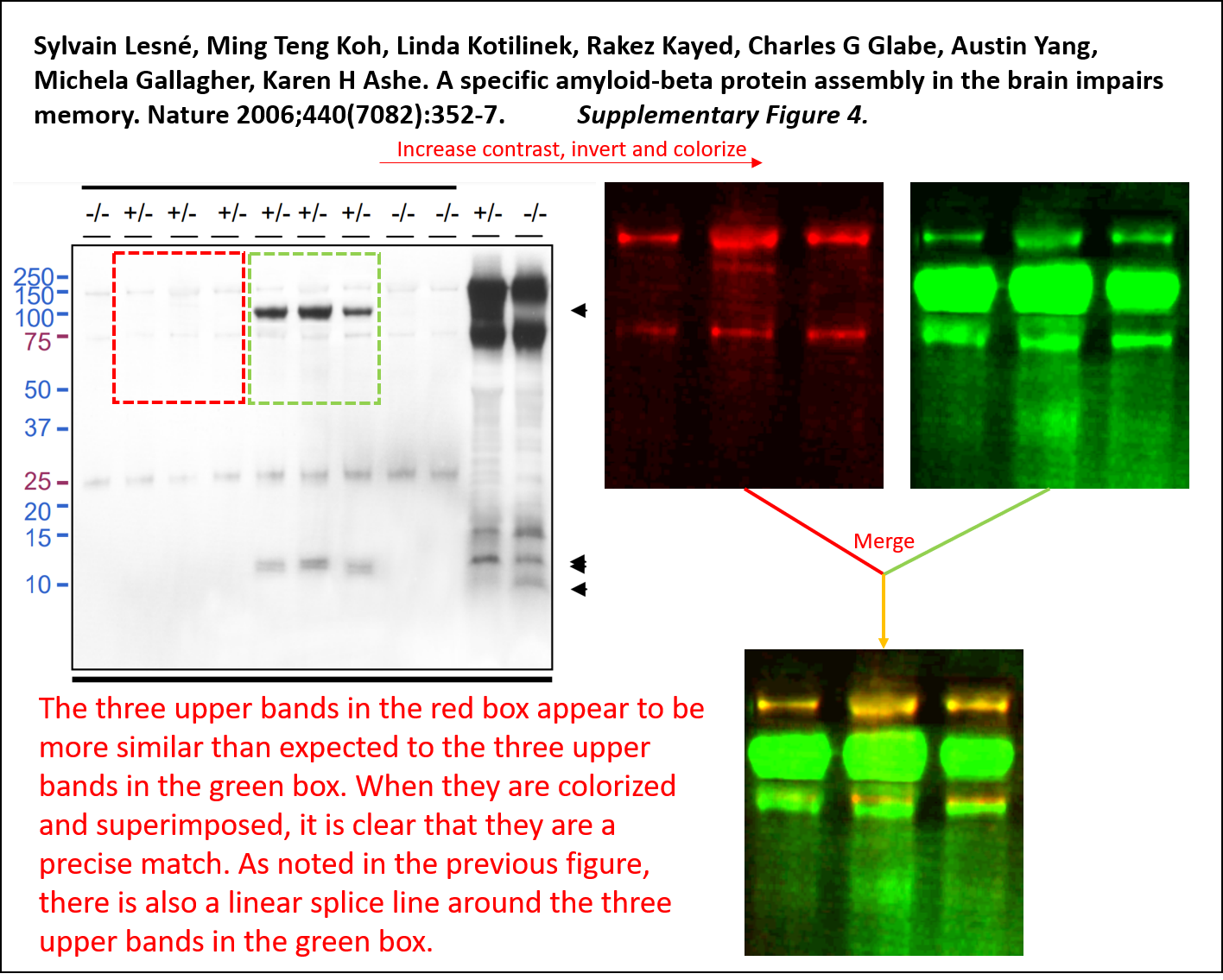
There were other problems with that paper, also Elisabeth Bik, invited by Science as one of the several experts to verify Schrag’s findings, found more copy-pasted gel sections. Knowing what was coming, Nature issued an Editor’s Note on 14 July 2022:
“The editors of Nature have been alerted to concerns regarding some of the figures in this paper. Nature is investigating these concerns, and a further editorial response will follow as soon as possible. In the meantime, readers are advised to use caution when using results reported therein.”
The last author, the University of Minnesota professor Karen Ashe, shared some “raw” data, allegedly proving that there was nothing untoward but innocent image processing artefacts from the side of the publisher. Which however failed to convince Schrag:
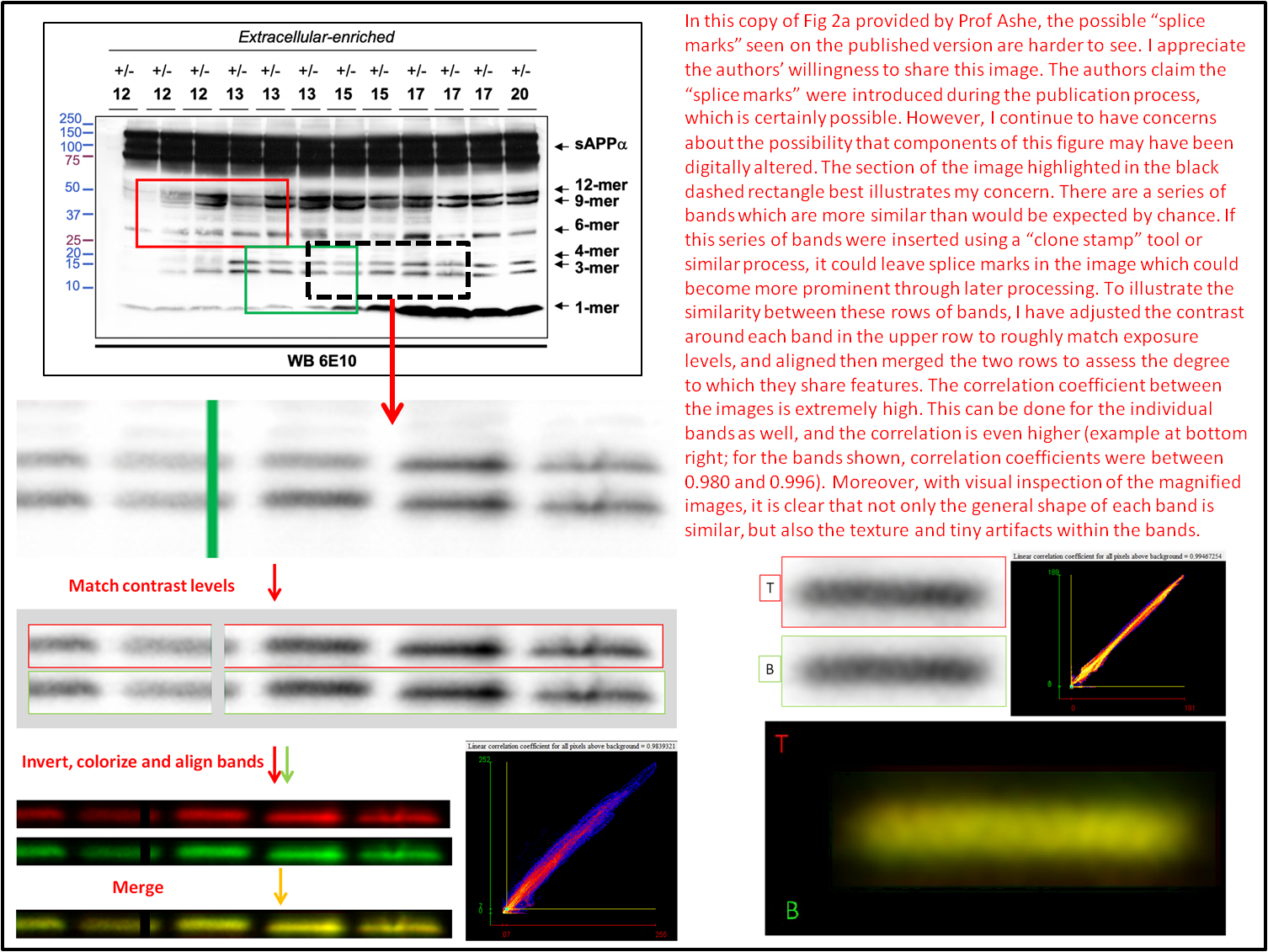
After the Science article broke, Lesne disappeared. It is not clear if he has been already suspended by the University of Minnesota or if he took a leave on his own accord to escape the attention. This is currently his auto-reply to emails:
“I am currently away from my office and I will not be able to respond
to your emails during that time.
Thank you for your understanding and patience.“
No time frame for his return specified. In any case, Lesne’s academic career is very likely to be over. Especially since this associate professor never even had full tenure in the first place, a rather unusual situation for someone credited with establishing an entire research field. His mentor Ashe urgently needs to save her own reputation, so she will withdraw not just her Nature paper, but also all support for her protege. Lesne is now the proverbial toast.
It is already the second huge biomedical fraud scandal at the University of Minnesota. Before, they had Catherine Verfaillie who postulated in Nature that the bone marrow contained pluripotent stem cells (spoiler: it does not). That 2002 Nature paper was also fraudulent, but it was never retracted because Verfaillie started a new career in her home country Belgium, as professor and director of a stem cell institute at KU Leuven. She was recently found innocent of research misconduct there.
Catherine Verfaillie, the Zombie Scientist of KU Leuven
Catherine Verfaillie is a zombie scientist: her past stem cell research long discredited, but she still is an influential and very well funded star of Belgian science. Now Elisabeth Bik had a fresh new look at Verfaillie’s papers
Science narrates how Schrag stumbled over Lesne’s fraud. The Vanderbilt sleuth was studying PubPeer in December 2021 and found Lesne’s papers being commented upon. Like this one, first commented by an anonymous user already in 2013 and followed up in July 2019 by Cheshire (Actinopolyspora biskrensis) and later also by Elisabeth Bik:
Megan Larson , Mathew A Sherman , Fatou Amar , Mario Nuvolone, Julie A Schneider , David A Bennett , Adriano Aguzzi, Sylvain E Lesné The complex PrP(c)-Fyn couples human oligomeric Aβ with pathological tau changes in Alzheimer’s disease The Journal of neuroscience (2012) doi: 10.1523/jneurosci.1858-12.2012
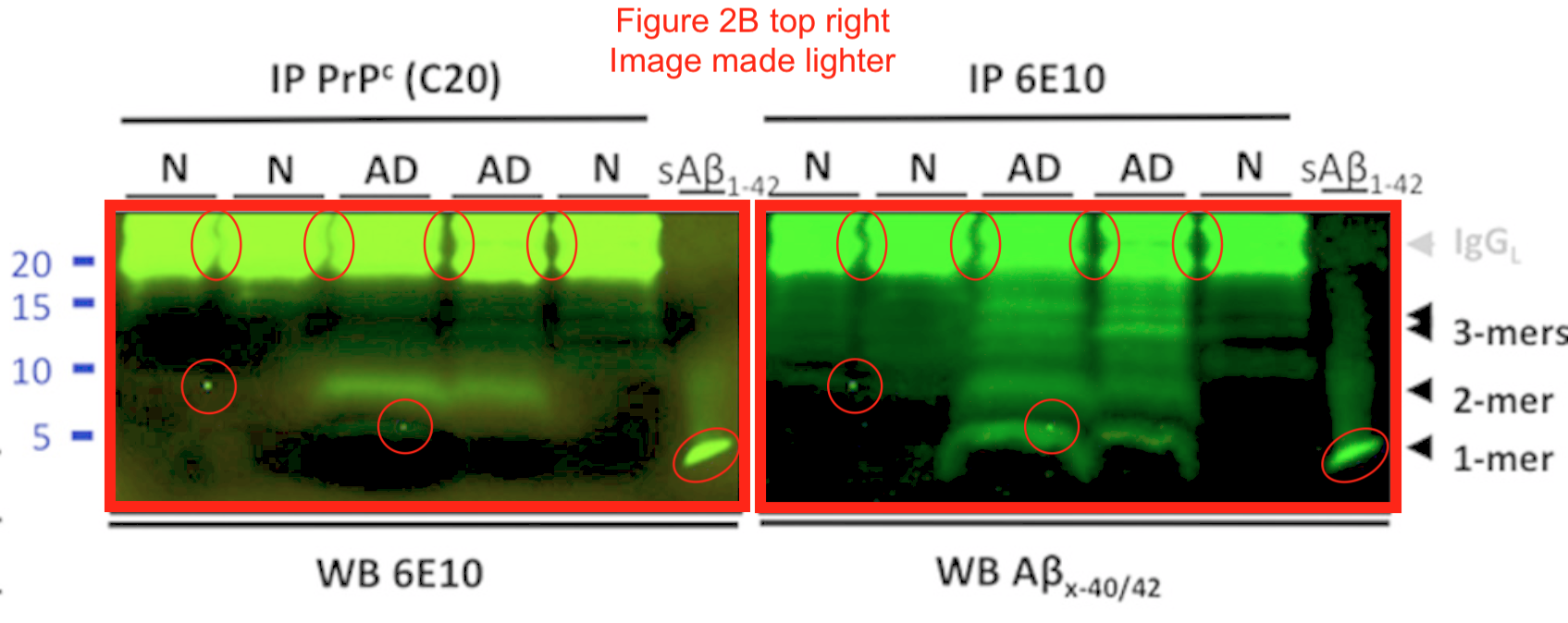

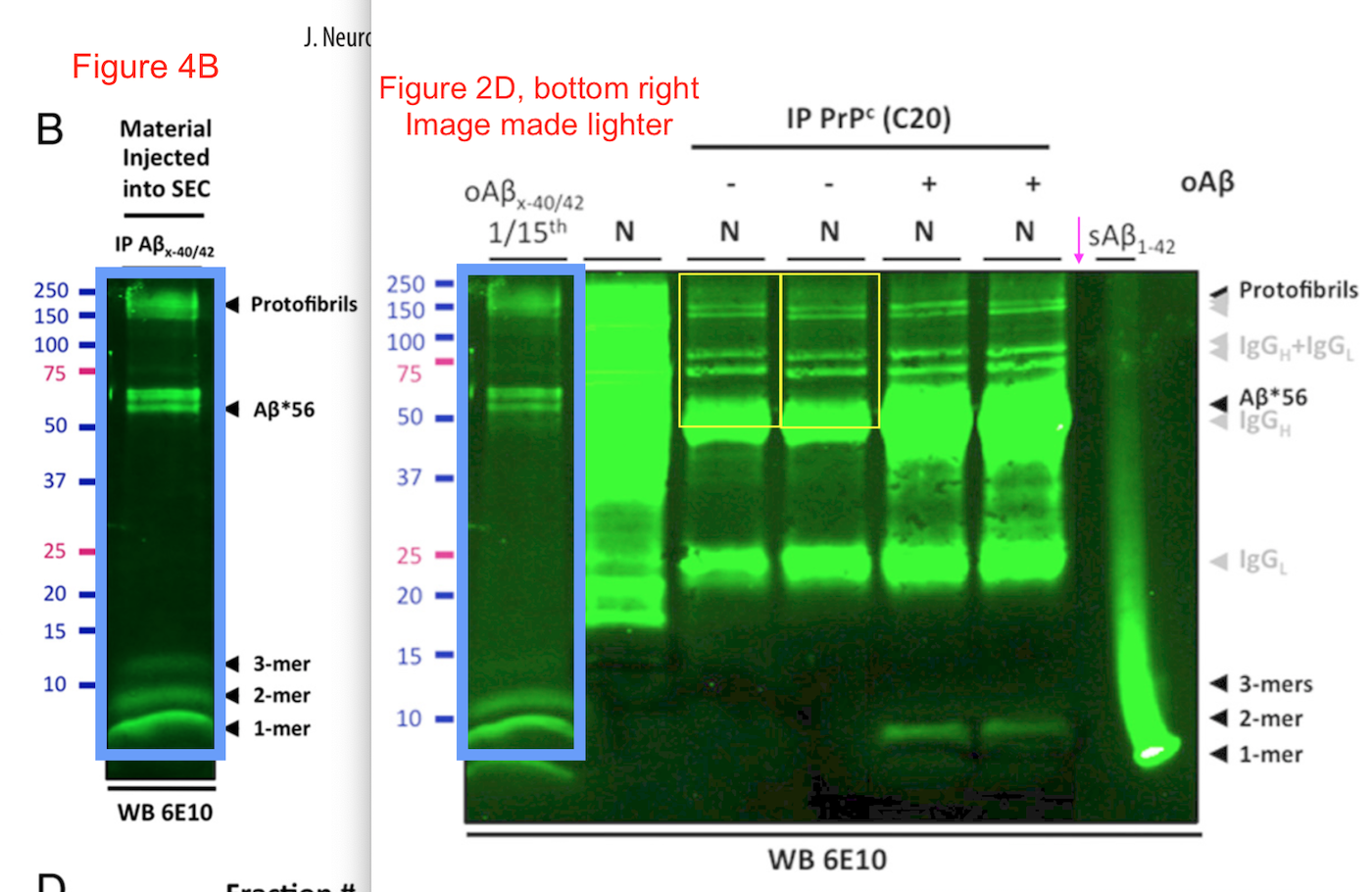
Thin magenta arrow. A sudden, sharp vertical line between the two right-most lanes suggests an undisclosed splicing.”

And this one, posted by Cheshire on 12 December 2021:
Mathew A Sherman , Michael LaCroix , Fatou Amar , Megan E Larson , Colleen Forster , Adriano Aguzzi , David A Bennett , Martin Ramsden , Sylvain E Lesne Soluble Conformers of Aβ and Tau Alter Selective Proteins Governing Axonal Transport The Journal of neuroscience (2016) doi: 10.1523/jneurosci.1899-16.2016


Those were the papers by Lesne on PubPeer which drew Schrag’s attention in the first place.
The Science article is very long and very detailed, but it doesn’t tell you why these two papers were possibly flagged by Cheshire in the first place, and which fellow neuroscientist Lesne must now thank for the end of his career.
That Italian-born Germany-trained prion researcher in Switzerland was subject to Cheshire’s and Bik’s sleuthing due to my past reporting. He is quite known on Twitter, as a diva prone to boasting, dishonesty, slander, trolling and flaunting the unconditional support he enjoys from his employer, the University of Zürich. He published a lot of problematic science with fishy figures, and even used to decorate himself with an imaginary PhD degree for decades, to exactly zero consequences. This full professor stands spread-legged and proud, taunting and threatening his critics, calling them criminals and “lowlifes”, while his collaborator Lesne whimpers under some table.
It is Adriano Aguzzi.
Science magazine doesn’t want you to know about Aguzzi’s case, because Aguzzi, unlike Lesne, is untouchable and invincible. And because For Better Science is the only source you can read about on the Zürich diva, despite his past announcements to sue me for every penny I have and then put me in jail (literal threats, yes).
Aguzzi and the Lowlifes
The prion researcher Adriano Aguzzi used to describe his Pubpeer critics as “lowlifes”, and himself as a victim of a lynch mob. But after Elisabeth Bik helped him find even more mistakes in his papers, Aguzzi changed his stance.
I suggest Lesne jumps on a plane to Zürich, and kisses Aguzzi on both of his ruddy cheeks for bringing the PubPeer sleuths upon his trail. I personally find all this hilarious.
I won’t reiterate Aguzzi’s antics here, you can read about his Twitter bullying of a postdoc here, and about his trash science on prions in my article from December 2019. And here is a new find by Bik, another falsified gel:
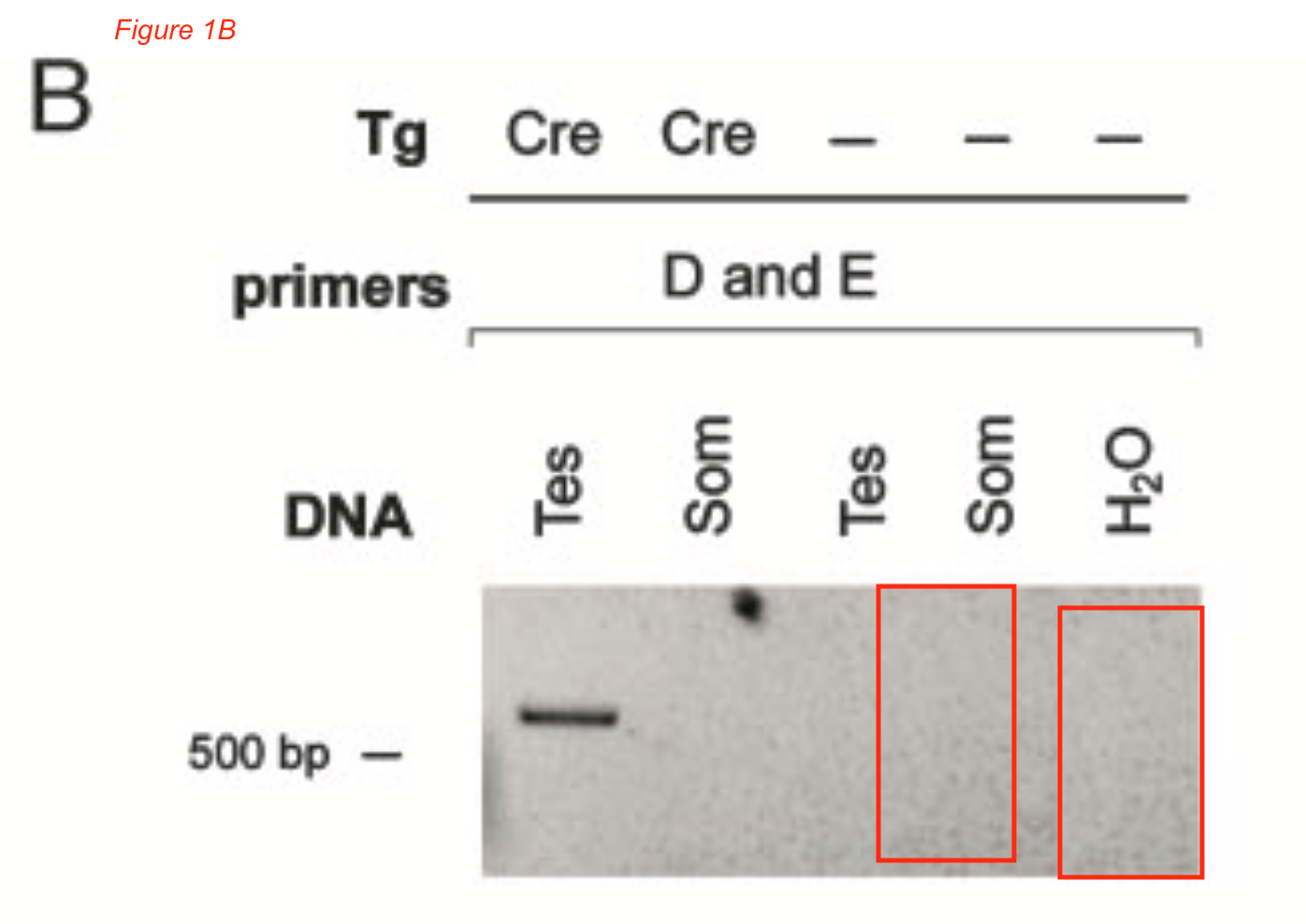
Nicolas Genoud, Axel Behrens, Gino Miele , Dimitri Robay , Frank L. Heppner, Stefan Freigang, Adriano Aguzzi Disruption of Doppel prevents neurodegeneration in mice with extensive Prnp deletions Proceedings of the National Academy of Sciences (2004) doi: 10.1073/pnas.0400131101
Aguzzi’s employer, the University of Zürich, buried the announced investigation into Aguzzi’s problematic publications and into his self-attributed PhD degree, and ended all communication with me ages ago. But they do occasionally send Aguzzi to Twitter to inform the public about the evilness of Schneider:
“There is a German guy who is obsessed with me and sends every one of my tweets to the president of my University asking him to fire me. Needless to say, he is being ignored.”
To be fair, Aguzzi deleted this tweet after I sent it to his university. But then there are his assumed sockpuppet’s tweets in support of the sacked sexual harasser from MIT, David Sabatini:
Sabatini is not just a sexual harnesser, he is also a research cheater. But the anonymous Twitter account “Dr Carmine Falcone” is (despite all the clues) officially not Aguzzi’s, so the University of Zürich is OK with whatever is being tweeted there.
The Sex Privileges of mTORman David Sabatini
“The Plaintiff is Professor Sabatini […] the self-described powerful senior scientist, who had demanded sex of her when she was a graduate student ending her studies and about to start a fellowship at the Whitehead, in a program Sabatini would direct. […] And it is the man who had made it clear – throughout her…
Now I would like to show you more fake science by that loser Lesne whose academic career was cut short in mid-flight, while Aguzzi can look forward to his upcoming retirement in Zürich (he is 62), with pomp and circumstance, laudatios by the rector and politicians, a Festschrift, media coverage, speeches by his mentees whom he brought over the decades into professorships or high medical and industry positions, etc etc. Lesne, merely 48, in the prime of his academic career, gets instead a kick in the behind.
Here is a beautiful Aβ*56 paper by Lesne which Schrag exposed as just another forgery.
Angie C.A. Chiang , Stephanie W. Fowler , Rohit Reddy , Olga Pletnikova , Juan C. Troncoso , Mathew A. Sherman , Sylvain E. Lesne , Joanna L. Jankowsky Discrete Pools of Oligomeric Amyloid-β Track with Spatial Learning Deficits in a Mouse Model of Alzheimer Amyloidosis American Journal Of Pathology (2018) doi: 10.1016/j.ajpath.2017.11.011

Just like Nature, Science also issued an Expression of Concern for a Lesne paper in one of its journals. It was initially flagged by Cheshire on 12 December 2021, possibly via the link to Aguzzi:
Fatou Amar , Mathew A. Sherman , Travis Rush , Megan Larson , Gabriel Boyle , Liu Chang , Jürgen Götz , Alain Buisson , Sylvain E. Lesné The amyloid-β oligomer Aβ*56 induces specific alterations in neuronal signaling that lead to tau phosphorylation and aggregation Science Signaling (2017) doi: 10.1126/scisignal.aal2021

Schrag chimed in, here one example:
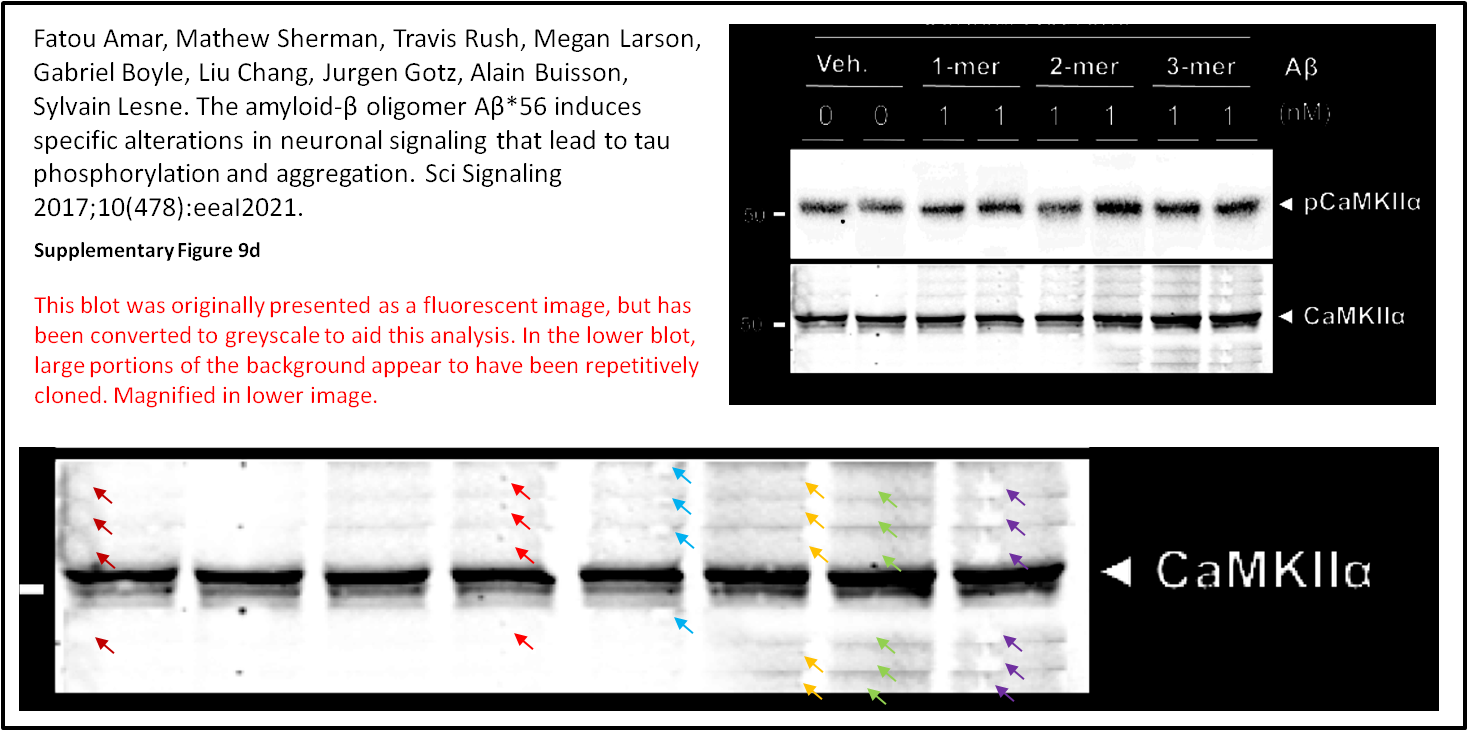
There was much more fraud in that paper, so on 21 June 2022 Science Signaling issued this editorial note:
“The editors have been made aware of accusations of data manipulation regarding Figs. 1A, 3A, and 6G, and figs. S9D and S12A, which are being investigated. We are publishing this Editorial Expression of Concern to make readers aware of these accusations while we await the outcome of the investigation.”

Another paper in Science Signaling, Alfonso et al 2016, also received an expression of concern:
“The editors have been made aware of accusations of data manipulation regarding fig. S1, which are being investigated.”
This study however only had Lesne as one of middle authors, the more significant contributors were others, like Michael Leitges, professor at Memorial University of Newfoundland with around a dozen of papers on PubPeer, which in turn were often co-authored by known cheaters like Harvard’s C. Ronald Kahn (over 50 papers on PubPeer) and INSERM’s Frédéric Checler (30 papers on PubPeer).
A corresponding author of that Alfonso et al 2016 paper is the Harvard professor Rudolph Tanzi, who protested on Retraction Watch:
“Please note I did not “lead” this study. I provided human genetic association data (from whole genome sequencing) for a rare PKC alpha gene mutation we found genetically associated with Alzheimer’s disease . None of the cell biology experiments were performed in my lab.”
Pontus Boström: cheater carousel in Sweden
Sweden is a tolerant country, which is a very good thing. Unfortunately, sometimes this Swedish tolerance seems ill-advised. Dishonest scientists caught faking data are happily given another chance and fat funding, like the case of the diabetes researcher Pontus Boström shows. This scientist was found to have fabricated data during his PhD studies with late…
But do not jump to conclusions that Tanzi is an innocent victim here. He also has several papers on PubPeer, in turn co-authored with cheaters like Harvard’s Bruce Spiegelman, MassGeneral’s Dora Kovacs (8 papers on PubPeer) or…. Deepak Chopra. Yes, the bestselling yoga quackery guru who also happens to be UCSD professor.
Guilty pleasures of meditating with Deepak Chopra
Smut Clyde will take you on a meditative Ayurvedic trip where the most respectable of research institutions and their world-renowned academics were caught dancing with the Guru Deepak Chopra himself. Famous cardiologist and medical writer Eric Topol and the Nobel Prize winner Elizabeth Blackburn were just two most prominent US academics listed on Chopra’s Panchakarma…
In another paper Lesne teamed up with the Stanford professor Tony Wyss-Coray, who makes serious money with anti-aging therapies with young blood or young spinal tap fluid transfusions. Of course Wyss-Coray also has a PubPeer record of problematic data.
Roger F. Gaertner , Tony Wyss-Coray, Dominique Von Euw , Sylvain Lesné, Denis Vivien, Pierre Lacombe Reduced brain tissue perfusion in TGF-beta 1 transgenic mice showing Alzheimer’s disease-like cerebrovascular abnormalities Neurobiology of Disease (2005) doi: 10.1016/j.nbd.2004.11.008

Rule of a thumb is that if you want to find research cheaters, all you have to do is follow one of them around. Again, this is how Cheshire possibly found Lesne, by following Aguzzi.
Bleed’em while they’re young
“There’s still a long way to go – blood is complicated. But there are many excellent labs focused on this, so I am optimistic about progress.” – Aubrey de Grey.
Without diminishing Lesne’s responsibility for massive research fraud, it looks like he will be the scapegoat for the sins of everyone else.
The amyloid plaque model of Alzheimer’s has failed, despite being oh so reproducible over so many hundreds if not thousands of research papers citing each other. This is perfectly common in academia, they usually pretend nothing happened and either continue with slight alterations or invent a new kind of bullshit. Recall how Verfaillie’s fake pluripotency of bone marrow cells resulted in masses of (often just as fraudulent) studies and culminated in deadly clinical fraud, especially Bodo-Eckehard Strauer‘s patient abuse and Paolo Macchiarini‘s killing spree. Now bone marrow cells are somewhat discredited as a regmed cure, but there are other sources of stem cell magic: skin, fat, blood, urine, anything easily accessible actually.
The stem cell faith healers, or magic inside your bone marrow
Bone marrow stem cells are magic, they can do everything. If you don’t believe it, you are simply a loser scientist and will never get funded. Prior to his bombastic fall from grace, the celebrity surgeon and professor of regenerative medicine Paolo Macchiarini was considered a genius stem cell wizard and a miracle healer. He…
Macchiarini’s trachea transplant patients: the full list
This article lists all known (including those not officially declared) patients of the scandal surgeon Paolo Macchiarini, who received from him a cadaveric or plastic trachea. It will be updated whenever I receive any new evidence.
But sometimes, research fields do spectacularly collapse. Piero Anversa‘s fake heart stem cells went out in a bang after he was sacked of Harvard, found guilty of fraud and had many of his papers retracted. But worry not: the public grant money continued to flow into that made-up research field even after the scandal became known. Because Anversa was by far not the only fraudster working on non-existent heart stem cells, and some of the guilty parties now play ethics heroes. One of them is Temple University’s dean Steven Houser who cleverly managed to denounce Anversa in due time.
Steven Houser and the Temple of Fraud
“We all hype our work. We want to tell people our work is important. These patients, many of them coming to enroll in these trials, they have no other hope.” -Steven Houser, Hero of Research Ethics, Temple University
Anversa was quite possibly brought down not so much by angry peers, but by angry pharma industry which wasted many millions chasing his fantasy heart stem cells as a cure of heart attacks, much of that money having ended in the private pockets of Anversa, his collaborators and bandwagon-riding peers worldwide.
And now pharma industry is very pissed off about Alzheimer’s. The amyloid plaque model became quite discredited in the recent years after one promising drug after another failed in Phase 3 clinical trials, and even the drug which despite harsh criticism did get an FDA approval – an amyloid beta-directed monoclonal antibody (Aduhem by Biogen) – performed highly unconvincingly. So bad, that in April 2022 Biogen withdrew its application with the European Medicines Authority. Time to close that wasteful chapter, ideally with finding and punishing the culprit.
Lesne is a perfect scapegoat. Everyone knew he was untrustworthy (this is also why he remained associate professor in Minnesota), a lot of people seem to dislike him, and the forgeries in his papers shout out fraud. Like this:
Megan E. Larson , Susan J. Greimel , Fatou Amar , Michael LaCroix , Gabriel Boyle , Mathew A. Sherman , Hallie Schley , Camille Miel , Julie A. Schneider, Rakez Kayed , Fabio Benfenati , Michael K. Lee , David A. Bennett , Sylvain E. Lesné Selective lowering of synapsins induced by oligomeric α-synuclein exacerbates memory deficits Proceedings of the National Academy of Sciences (2017) doi: 10.1073/pnas.1704698114



This other study by Lesne and Ashe has already been corrected, after Schrag found fake gels:
Sylvain E. Lesné , Mathew A. Sherman , Marianne Grant , Michael Kuskowski , Julie A. Schneider, David A. Bennett, Karen H. Ashe Brain amyloid-β oligomers in ageing and Alzheimer’s disease Brain (2013) doi: 10.1093/brain/awt062


A correction from 13 May 2022 (which you are expected to pay €41 for to read) declared:
“The authors apologize for errors in Fig. 1 and Supplementary Figs 1, 3 and 5, as detailed below. The corrected images are provided only in this corrigendum to preserve the published version of record.”
But now this corrected paper will probably be retracted by Ashe, because Schrag noticed that the authors submitted forged “raw data”:

Due to admitted digital manipulations, the paper’s conclusions went down the toilet, even if the journal considered those unaffected:

From experience, I can assure you that research fraud never affected any conclusions in any of the fraudulent papers. I have further expert testimony here, from the Science article – a co-author admitting that yes, Lesne is a fraudster to be avoided, yes, every figure he submits is fake and can’t be trusted, but if that fake paper has already been published with my name on it, it is overall still fully reliable so please do not retract it:
“Questions about Lesné’s work are not new. Cell biologist Denis Vivien, a senior scientist at Caen, co-authored five Lesné papers flagged by Schrag or Bik. Vivien defends the validity of those articles, but says he had reason to be wary of Lesné.
Toward the end of Lesné’s time in France, Vivien says they worked together on a paper for Nature Neuroscience involving Aβ. During final revisions, he saw immunostaining images—in which antibodies detect proteins in tissue samples—that Lesné had provided. They looked dubious to Vivien, and he asked other students to replicate the findings. Their efforts failed. Vivien says he confronted Lesné, who denied wrongdoing. Although Vivien lacked “irrefutable proof” of misconduct, he withdrew the paper before publication “to preserve my scientific integrity,” and broke off all contact with Lesné, he says. “We are never safe from a student who would like to deceive us and we must remain vigilant.”
Schrag spot checked papers by Vivien or Ashe without Lesné. He found no anomalies—suggesting Vivien and Ashe were innocent of misconduct.”
Help with another? Not on PubPeer yet
This guest post by pseudonymous Cheshire, shows that everyone can become an image integrity sleuth. You don’t need to be a scientist, just use common sense and some Twitter advice
Actually, it was once again Cheshire who flagged some of these papers. But his association with that horrid Schneider and For Better Science precluded a mention in the Science article. The sleuth posted several papers by Lesne on 12 December 2021, some with, some without Aguzzi. This is why he isn’t sure anymore about having followed one from the other. Otherwise, Cheshire told me:
“I think it was the retraction of a Jun Tan (University of South Florida) paper that I had flagged in 2019 that started me thinking about problems in Alzheimer’s research more broadly. That retracted study was about a drug that is now licensed to Alzamend.“
I briefly mentioned the company Alzamend in this article, and it was this paper, retracted after “an investigation by the University of South Florida“:

Cheshire added:
“This was from the first author’s PhD thesis – and I think he’s at NIH now [Ahsan Habib, postdoctoral visiting fellow, – LS]. That drug is apparently now in clinical trials and I think Alzamend could be just a scam… at least things seem to be very odd there. I had also been working on Athira.“
Athira Pharma is yet another biotech startup seeking to push an Alzheimer’s drug based on falsified data from the PhD research of company’s founder, Leen Kawas.
How to cure all diseases
“I have a passion to solve a problem that is facing millions. I could have a job that makes more money, has normal hours, but this is where I should be right now.” Dr Leen Kawas, CEO of Althira Pharma
But we digress, you see how much Alzheimer’s fraud is out there, all very successful in treating those amyloid plaques in Photoshop. Let’s go back to Lesne. Cheshire posted this on PubPeer on 12 December 2021, and then Bik joined:
Sylvain Lesné, Carine Ali , Cecília Gabriel , Nicole Croci , Eric T MacKenzie , Charles G Glabe , Michel Plotkine , Catherine Marchand-Verrecchia , Denis Vivien, Alain Buisson NMDA receptor activation inhibits alpha-secretase and promotes neuronal amyloid-beta production The Journal of neuroscience (2005) doi: 10.1523/jneurosci.0849-05.2005


The shape of this band resembles that of the right-most band in the APP751 gel“
Also this one was originally flagged by Cheshire on 12 December 2021:
Megan E Larson , Mathew A Sherman , Susan Greimel , Michael Kuskowski , Julie A Schneider, David A Bennett , Sylvain E Lesne Soluble α-synuclein is a novel modulator of Alzheimer’s disease pathophysiology The Journal of neuroscience (2012) doi: 10.1523/jneurosci.0581-12.2012

Schrag joined and found more fraud:



The society-owned journal swiftly issued an Erratum, on 15 June 2022:
“In the article[…] Western blots in Figures 1, A and B, 2B, and 5A were processed inappropriately, and therefore the published figures appeared incorrectly. The authors regret these errors and note that the scientific conclusions of the article were not affected. The corrected figures and their legends, which were not changed, appear below.”
But Schrag found the corrected figures to be fraudulent as well, also Cheshire and Bik were not convinced:

“One of the figures that does not appear to have been discussed previously, nor addressed in the correction, is Figure 2A.“
But on the side of Journal of Neuroscience and its venerated Society for Neuroscience, the case is closed. What can you expect, these professorial clowns of neuroscience proudly used to have that sociopathic fraudster BethAnn McLaughlin run their Twitter account.
BethAnn McLaughlin affair: now also research fraud?
BethAnn McLaughlin is a liar, a racist, an embezzler, and a dangerous manipulative bully. But surely she is at least a great neuroscientist?
Science mentioned:
“The Journal of Neuroscience stands out with five suspect Lesné papers. A journal spokesperson said it follows guidelines from the Committee on Publication Ethics to assess concerns, but otherwise had no comment.”
What Science did not mention, although very relevant in the context of their own story, is that this same society journal just recently declared an utterly fake Cassava paper to be perfectly fine because the authors submitted “raw data”. Which proved to be fake also. Some information is best not to be disseminated or the lab equipment, pardon, PhD students and postdocs will drop their pipettes and walk out in protest.
Facts and Fiction of Cassava Sciences
Attack is the best form of defence. Especially when your commercial clinical research is tainted by preclinical Photoshop fraud.
And actually, if Science and its editors and journalists are so supportive of Elisabeth Bik and so interested in the topic of fraud in neuroscience, may I remind you about this, from my older article:
Two very fake Science papers by the influential neuroscientist and President of the Stanford University, Marc Tessier-Lavigne.
It seems a former lab member named Elke Stein had a penchant for data falsification. This can happen. Yet Tessier-Lavigne never retracted any of their joint papers, there is no expression of concern, not even a correction. The Stanford president simply lets these fraudulent studies stand, and the elite journal is more than eager to oblige him.
E. Stein , Y Zou , M Poo , M Tessier-Lavigne Binding of DCC by netrin-1 to mediate axon guidance independent of adenosine A2B receptor activation Science (2001) doi: 10.1126/science.1059391

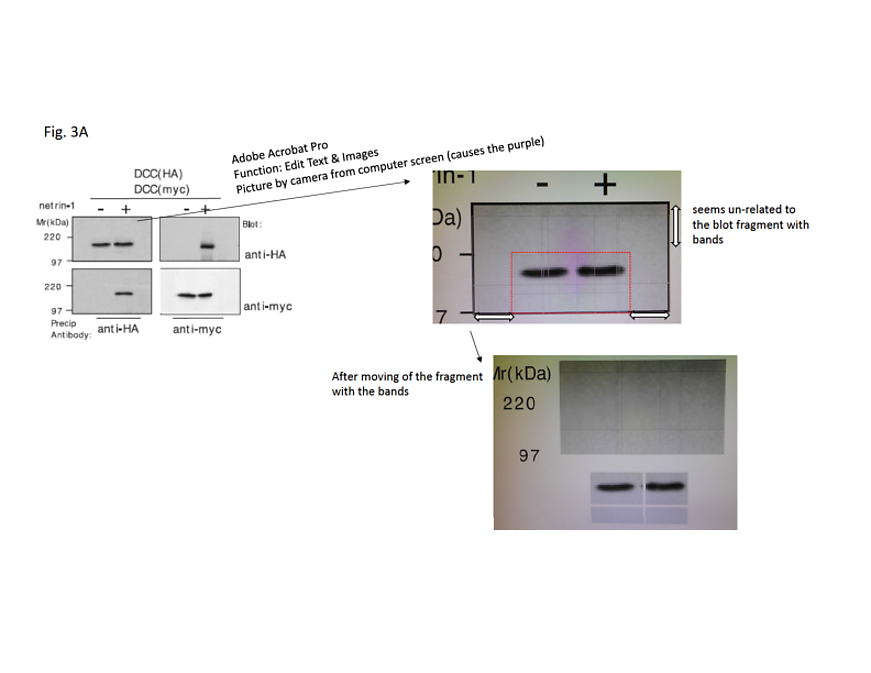
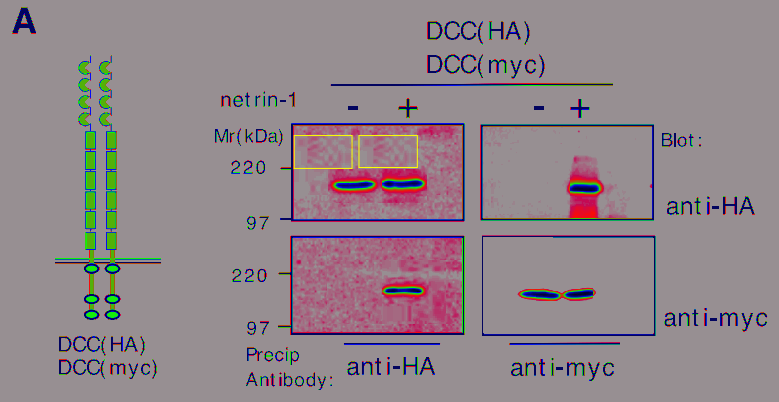
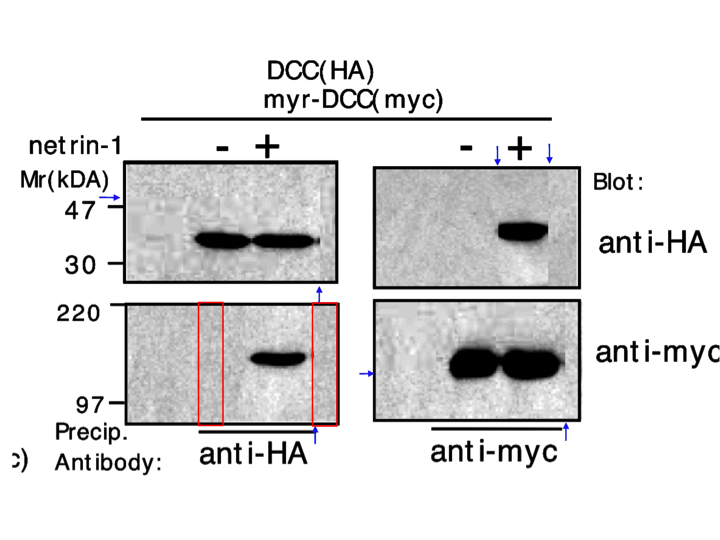
Here is the other masterpiece:
E. Stein , M Tessier-Lavigne Hierarchical organization of guidance receptors: silencing of netrin attraction by slit through a Robo/DCC receptor complex Science (2001) doi: 10.1126/science.1058445
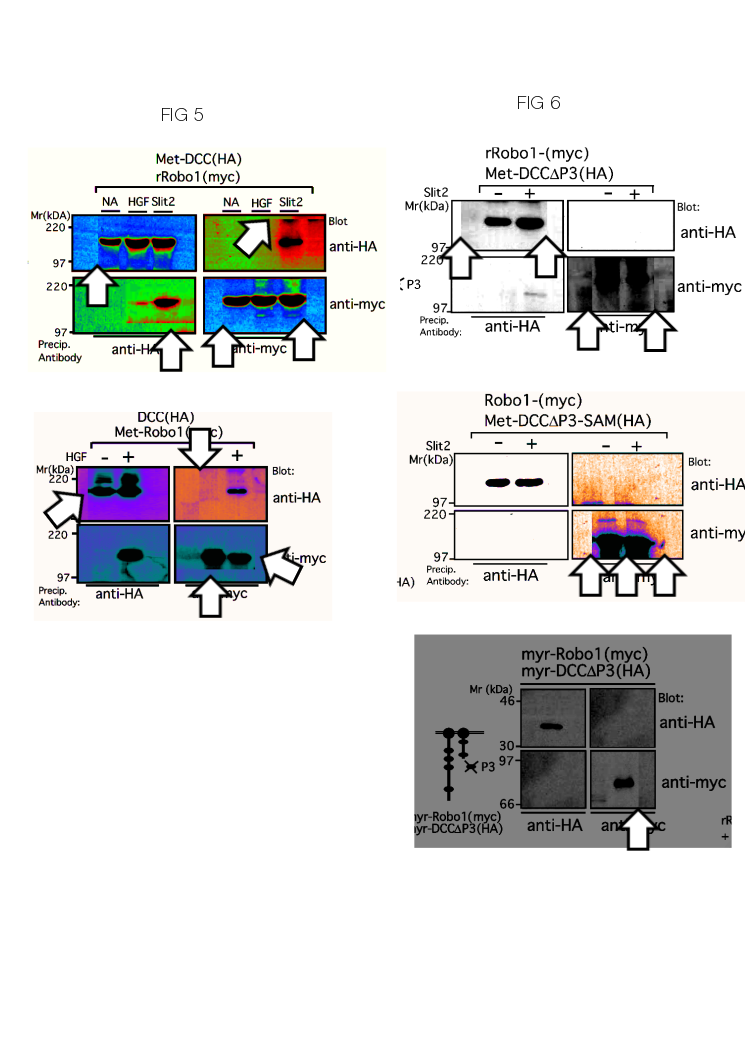
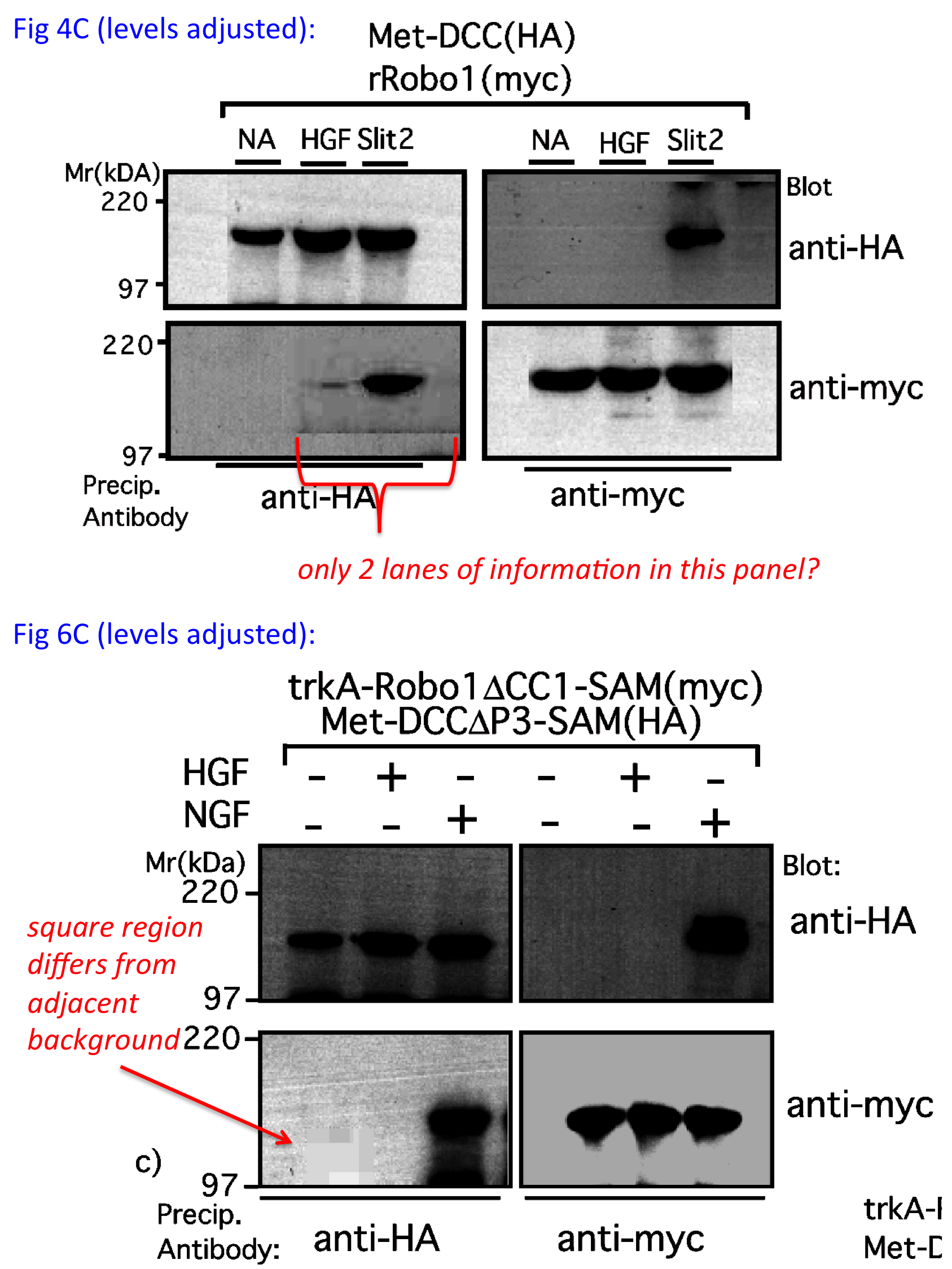

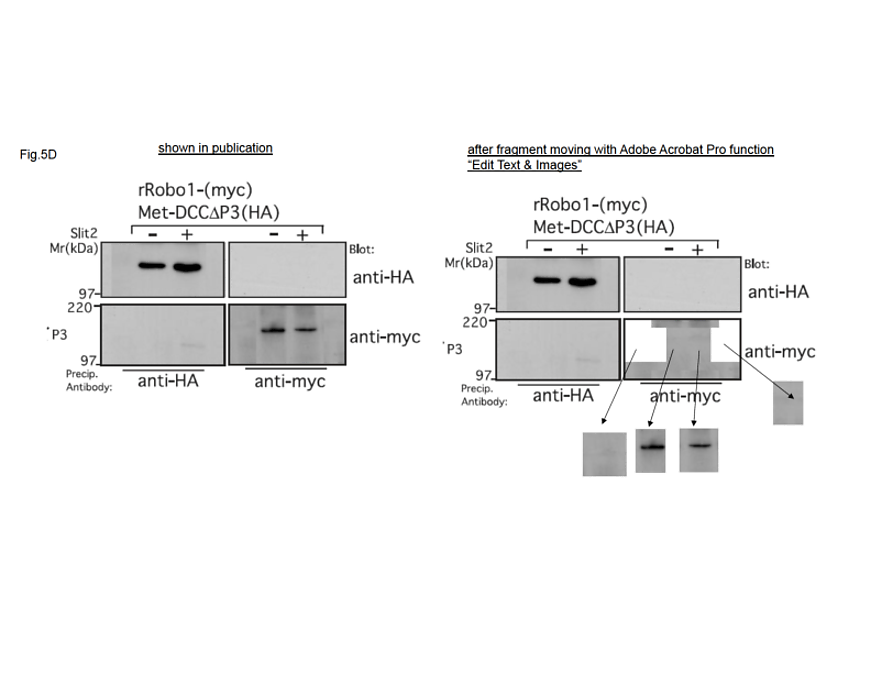
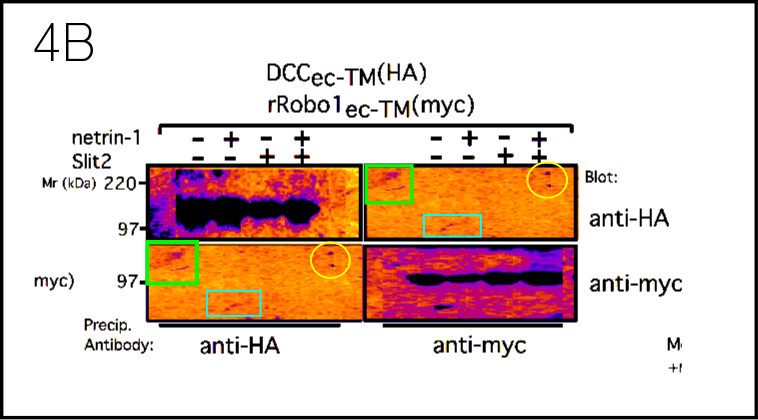

Stein was punished, she was apparently quietly let go as associate professor at Yale. But after she failed to establish herself in alternative careers (including with a business called “Scientists against peer sabotage“), Tessier-Lavigne brought her back to Stanford in 2018 as a “visiting faculty scholar”, and she still is visiting there.
Science misconduct
Scholarly publishing is broken, and no repair is possible. At least let’s point fingers at the elites and laugh. Can science trust Science?
Tessier-Lavigne may be French like Lesne, but he is not some sad loser, a failed scientist who at the age of 48 remains associate professor hanging on his mentor’s proverbial skirt. This is why you will never read bad things about the Stanford President in Science, and his fraudulent papers there will forever remain perfectly safe, pristine and untouched.
For Science to function, you must have an illusion that the academic authorities have got everything under control. Read Science, never For Better Science.
I thank all my donors for supporting my journalism. You can be one of them!
Make a one-time donation:
I thank all my donors for supporting my journalism. You can be one of them!
Make a monthly donation:
Choose an amount
Or enter a custom amount
Your contribution is appreciated.
Your contribution is appreciated.
DonateDonate monthly



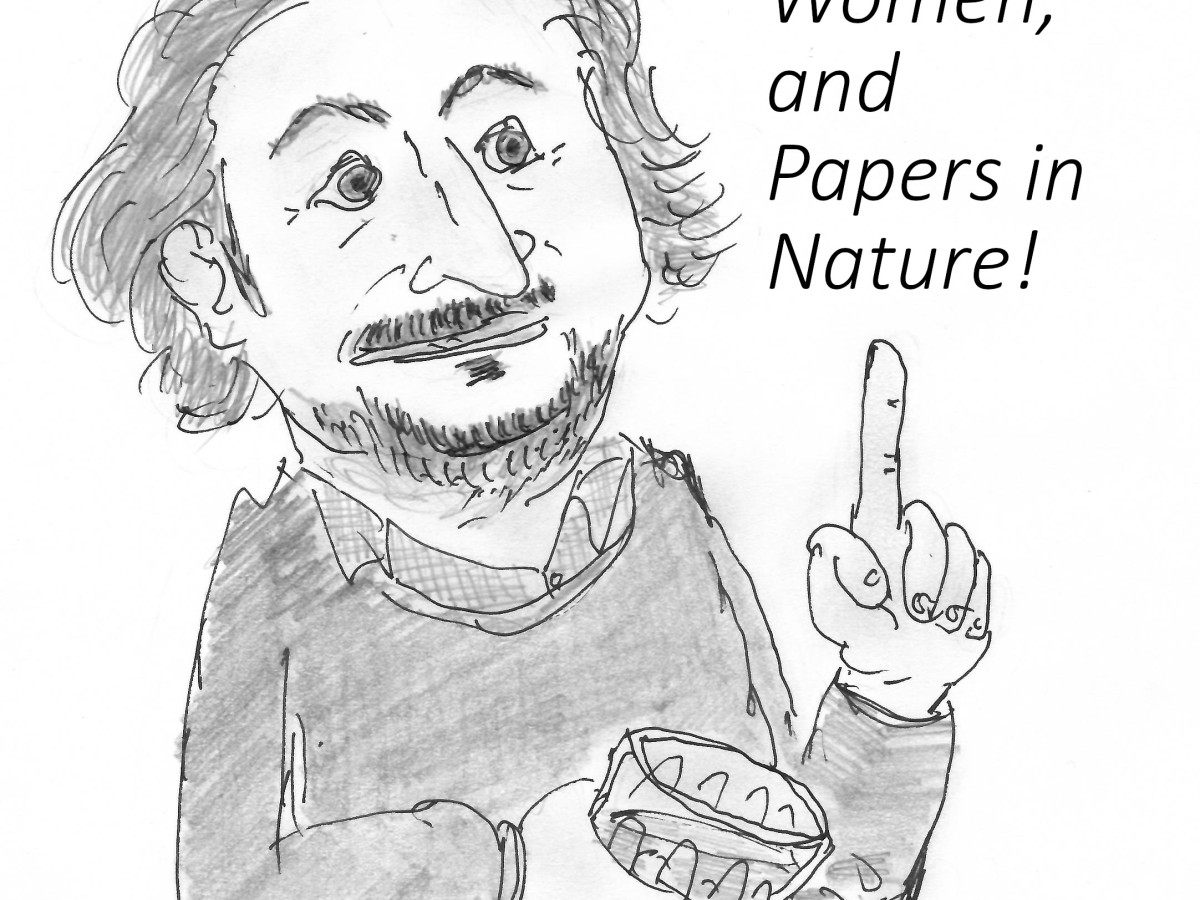




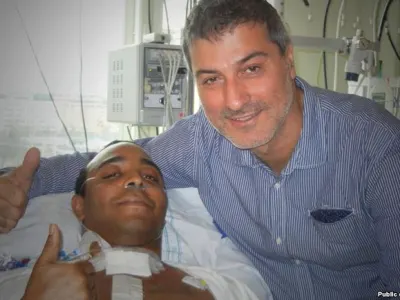







Cheshire is a paid shrill for Big Phama (or something). That anonymous git isn’t even a scientfish and therefour cannot have an opinion about our things. /s
Yes, Leonid is annoying.
Yes, he exaggerates.
BUT. You f*cks that read this site totally know that he is 100% right, and then you go about your business. In my mind, that is unethical. You are part of the problem. You are watching unethical and even illegal things happen and don’t say a word. In my opinion, when you remain silent, you become guilty.
Hopefully Leonid’s investigations make you think twice before going about your day.
LikeLike
You are annoying as well and keep harassing very respectable scientists, just like your awful mates Smut Clyde and Clare Francis! This is why the Science investigation never mentioned you.
LikeLike
https://forbetterscience.com/2020/10/22/the-pratfalls-of-domenico-pratico/
LikeLike
I don’t think all the credit should go to Sylvain Lesné.
There is also the extensive work by Frédéric Checler.
https://cvscience.aviesan.fr/cv/661/frederic-checler
Slightly old news.
https://www.vaincrealzheimer.org/2014/10/03/le-docteur-frederic-checler-membre-du-conseil-dadministration-de-lecma-remporte-le-prix-claude-pompidou/
As we know Prizes are validation that the data are correct.
The data.
https://pubpeer.com/search?q=checler
LikeLike
I did not read any criticism of Prof Checler’s work in Science (an neither in Nature).
Which means it is 100% reliable and trustworthy.
LikeLike
Giovanna Mallucci also deserves credit.
https://www.neuroscience.cam.ac.uk/directory/profile.php?gm522
The data:-
https://pubpeer.com/publications/DF38BCCD8F6B4A7908450F9032EB4F
https://pubpeer.com/publications/B619088AB412E4B323ADEDAE286F6E
LikeLike
If only he had taken a research ethics oath when defending his PhD thesis…
LikeLiked by 1 person
Or a research integrity course with Laurence Drouard. Who just got promoted to an exceptional research director, first rank. https://epst-sgen-cfdt.org/?p=28343
LikeLiked by 1 person
Is there anyone out there that realizes how many scientists are cheating? Cheaters are of any scientific size, from Nobel laureates down to small PIs in small universities in rural areas somewhere. I don’t think honest people realize how many cheaters lurk around them. And all reasearch fields are heavily affected: Alzheimer, oncology, stem cells, not to mention those toxic dumps called pathology, toxicology, pharmacology, and then also material science, plant science, mathematics, nanotecnology, etc, etc, etc, etc. How many billions do we still have to waste before extreme measures will be taken to wipe out this avalanche of trash?
LikeLiked by 1 person
Unfortunately, research fraud has become so widespread that it now un-containable.
LikeLiked by 1 person
He’s not a failed scientist if he brought in grant money. At least that is how UM sees it.
LikeLike
But now, things are about to change. Not only there won’t be any grant money, NIH might demand money back.
A failed scientist.
LikeLike
What’s the probability none of the researchers having used those papers as basis for their own work noticed the photoshoping? Seriously, what’s the figure? I would rather suspect the whole field is a crook circle of fraudsters. That would also explain why virtually 0 progress has been made in Alzheimer research.
LikeLike
Good thing the situation in cancer research field is so much better!
Here for example, Dr Croce found two cheating women in his lab, cleaned the stable, now a cancer cure is in reach!
https://www.nature.com/articles/d41586-022-02002-5
https://forbetterscience.com/2022/05/31/croce-begat-calin-and-calin-begat-girnita/
LikeLike
Don’t miss Derek Lowe’s commentary on this sad affair. The entire field is shit, and has been from day one of the amyloid affair.
https://www.science.org/content/blog-post/faked-beta-amyloid-data-what-does-it-mean?utm_source=Nature+Briefing&utm_campaign=82d0f0dfa9-briefing-dy-20220727&utm_medium=email&utm_term=0_c9dfd39373-82d0f0dfa9-42588799
LikeLike
You thinks it’s worse than with cancer research? Or anti-aging?
LikeLike
Cancer research is an enormous enterprise, which guarantees wastage and infestation by cranks. I think it is a different category of disaster when an entire field goes down the wrong road as a result of fraud and magic thinking. From the zero-sum investment perspective, the net effect of cancer research has undoubtedly been massive. But with regards to the negative impact on the advance of knowledge it is difficult to top this example, or cardiac stem cells and pretty much all of nanobiotechnology. It’s a not a matter of which is worse, but how the system can be reformed to forestall such enormous waste. It might be a good idea to try and build some administrative competence into the granting system, for starters. As for the continued shocking ineptitude of big pharma in chasing boojums, that’s a matter for investors.
LikeLike
and @citrus:
sure, I see your points. But exactly because cancer is a much bigger field, you get various different schools of thoughts on where cancer exactly comes from and how it is to be treated.
How about the microRNAs as the cause for cancer? A huge field, never overthrown, and flooded by Chinese papermill trash these days.
Postulated originally by Croce and Calin.
With Lesne, it does look like science actually self-corrected more or less. As Derek Lowe writes, his fake AB*56 crap never made it into clinical trials. It transpires that people understood right away it was fake, but left it alone as not to stir trouble, and just let Ashe and Lesne continue toiling in their corner. Lesne remained dependent of Ashe to this day, never made it to full professor.
The amyloid plaque hypothesis was a mistake all considered, but it persisted for so long because everyone either had their own line of fraud to cash in on it, or was too polite or too afraid to say something.
But ok, regenerative medicine is even worse than cancer. Anversa’s fictional heart stem cells were not just “reproduced”, they created a whole research field of many independent labs!
LikeLike
Cancer research did deliver some useful therapies. And we have a rather good understanding of what cancer is. As far as I know, the Alzheimer’s research field didn’t deliver any good treatment. It seems even finding the cause of the disease is getting nowhere.
LikeLike
Great sum up of Lesne affair:
” I’m not sure how many groups tried to replicate the findings, although (as just mentioned) when people did it looks like they indeed couldn’t find the *56 oligomer. And judging from the number of faked Westerns, that’s probably because it doesn’t exist in the first place.”
And that’s why the guy is still associate professor hanging onto Ashe’s skirt.
LikeLike
Pingback: El caso Lesné y la hipótesis amiloide en la enfermedad del alzhéimer - La Ciencia de la Mula Francis
Pingback: Prof Elizalde’s Magic Cancer Research at CONICET – For Better Science
Pingback: Research misconduct: Theory & Pratico – For Better Science
Another member of the club
https://www.science.org/content/article/misconduct-concerns-possible-drug-risks-should-stop-stroke-trial-whistleblowers-say
LikeLike
“Under Zlokovic’s leadership, the USC institute has expanded to more than 30 labs and grown its annual funding more than 10-fold, exceeding $39 million in 2022. NIH grants to Zlokovic have totaled about $93 millon”
That’s more than Carlo Croce’s $86 million.
Snowball’s chance in hell that USC will do anything about the problematic data. So much riding on it.
LikeLike